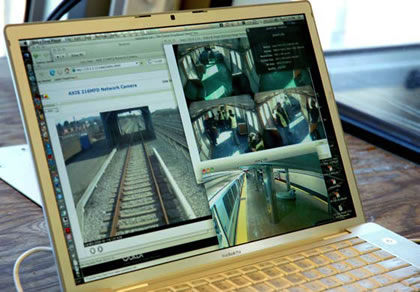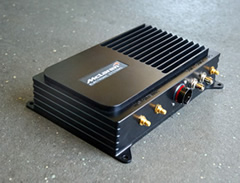|
|
Technology |
|
The Company’s above ground WiFi Rail Network is comprised of proprietary poles, fiber optic backbone, Cisco radios, photovoltaic panels, and electronic power management systems. The Company’s poles are engineered to exceed rail industry standards and are built to withstand 140 mph hurricane speed winds and 8.5 level earthquakes. The WiFi Rail Network is “21st Century Green,” utilizing solar energy to power the systems and charge the deep cycle batteries. The Company can also deploy small vertical axis wind generators for electric power. The Company’s poles are designed to “stand-alone” and require only the fiber-optic backbone connection.
The Company has created new proprietary designs for multiple-input and multiple-output (MIMO) directional antennas. These newly designed antennas incorporate multiple antenna filaments to produce the required special diversity for the MIMO algorithm that improves the Company’s network base technology. The new antenna designs include yagi and parabolic dish antennas for poles and directional antennas for mobile vehicles. All are designed to support both 2.4GHz & 5.8GHz for full 802.11n implementations. The Company is co-developing rack mount modular communication chassis for transportation systems. The new chassis will provide power, connectivity to the vehicle, and interconnection to other cards. The chassis will support RF cards for 200 MHz, 2.4, 3.7, 4.9, 5.8 and 5.9 GHz, video server cards, Ethernet switch cards, server cards, and data logger cards. The chassis will also connect the logger to the myriad of inputs from the various train systems. The Company has four patent applications on file with the U.S. Patent and Trademark Office. The Company will continue an active intellectual property protection program and expects to file additional patent applications related to recent technology developments. 1. 20080125129 SYSTEM FOR PROVIDING REDUNDANT COMMUNICATION WITH MOBILE DEVICES |
|
Product Traction |
|
Bay Area Rapid Transit The Company is currently working on phase two of a five phase installation on BART (Bay Area Rapid Transit) after signing an exclusive twenty year agreement to offer end-to-end solutions for the rail operator, rail passenger, and safety and security agencies. The signing of this contract came after the Company completed its Phase I proof of concept that tested and verified the network could successfully deliver continuous wireless connectivity to moving train cars at over 80 mph. To date, WiFi Rail has installed and tested connectivity that includes: 3.5 miles above ground, 5.5 miles of underground tunnel, four underground stations in San Francisco, and subterranean access through the tubes connecting the stations and partial coverage of the transbay tube.
American Recovery and Reinvestment Act (ARA ) Positive Train Control (PTC) The Company expects its proprietary technology can play a key role in the legislatively mandated requirements associated with positive train control. PTC refers to technology that is capable of preventing train-to-train collisions, over-speed derailments, and casualties or injuries to roadway workers (e.g., maintenance-ofway workers, bridge workers, signal maintainers). PTC is also capable of preventing train movements through a switch left in the wrong position. PTC systems vary widely in complexity and sophistication based on the level of automation and functionality implemented, the system architecture utilized, the wayside system upon which they are based (i.e., non-signaled, block signal, cab signal, etc.), and the degree of train control desired. Prior to October 2008, PTC systems were being voluntarily installed by various carriers. However, the Rail Safety Improvement Act of 2008 (RSIA) has mandated the widespread installation of PTC systems by December 2015. Currently, all of the affected railroads are aggressively pursing development of PTC implementation plans required by the RSIA and are adapting their individual PTC systems to maximize interoperability. Testing and Validation Thorough testing of the WiFi Rail Network has verified that the WiFi Rail Network provides sufficient speed and continuity for multi-megabit wireless Internet service toa multitude of simultaneous users. The Company team has experimented with a variety of antenna and radio configurations to achieve optimum results. Throughput tests via the widely recognized evaluation service provided by www.speedtest.net recorded typical results to the end user of 15Mbps in both upload and download speed. Results as high 22Mbps in either direction have also been recorded.
Internet access has, to date, been provided free to users registered. This arrangement has provided the Company the opportunity to test the network with “real” users, in significant volume, and to ensure the integrity and speed of the WiFi Rail Network. To date, over 20,000 different users have registered and used the system totaling more than 100,000 authentications. Users have had the ability to request technical support via email; however, in more than a year, the Company has received fewer than twenty requests for support, mostly for lost passwords or questions about coverage |
|

 The Company has created a new radio frequency (RF) separation system, which permits the co-existence and isolation of multiple RF signals commonly encountered, and desired, in underground transportation environments. Trunk radio systems, VHF/UHF radios, cellular telephones, WiFi, WiMax, and Safety and Security bands can propagate through a common medium and need only be separated at each repeater location. This new combiner/separator provides underground systems the ability to use one common cable instead of multiple, provides higher quality signal strength for each frequency group, and avoids the cost of installing and supporting multiple RF networks in a transit corridor.
The Company has created a new radio frequency (RF) separation system, which permits the co-existence and isolation of multiple RF signals commonly encountered, and desired, in underground transportation environments. Trunk radio systems, VHF/UHF radios, cellular telephones, WiFi, WiMax, and Safety and Security bands can propagate through a common medium and need only be separated at each repeater location. This new combiner/separator provides underground systems the ability to use one common cable instead of multiple, provides higher quality signal strength for each frequency group, and avoids the cost of installing and supporting multiple RF networks in a transit corridor. Safety and Security
Safety and Security